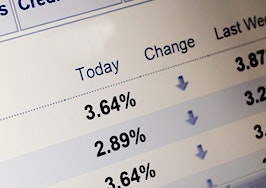- Upward movement in both German and Japanese bond helped push rates higher in the U.S.
- The Fed will go to 0.75 percent on December 14, and authentic signs of wage growth mean that the Fed is an even-money bet to hike 0.25 percent every 90 days in 2017.
- We can hope for temporary downward corrections and a low cycle-top if Trump offers strong support for the Federal Reserve and for budget discipline. Without that, this is going to get uglier.
The U.S. 10-year T-note is rising in yield again, now 2.35 percent, up a half-percent since election day. Mortgages are rising accordingly, close to 4.125 percent.
Did Donald Trump do that? We have some recent experience with black swan events, but not with a bird sporting an orange comb-over.
The global move-up
Part one: A global move up in long-term bond yields began in summer.
The low for Japan’s 10-year on July 27 was -0.29 percent (note minus signs); on U.S. election day, it had risen to -0.064 percent.
The German 10-year bottomed at -0.19 percent on July 8; by election day, it had risen to 0.21 percent — almost as big an increase as the U.S. 10-year after election day.
Donald Trump had nothing to do with that. Since election day, those two bonds have moved little, and ours caught up.
That global rise was caused by the ECB (European Central Bank) and BOJ (Bank of Japan) both confirming intent to push inflation up, continuing to buy IOUs from the market, but to cease pushing down long-term rates.
Each central bank runs QE (quantitative easing) of $80 billion per month, but buying short-term paper.
The BOJ will hold its 10-year at 0.0 percent, but the ECB has made no commitment to hold down long-term yields. The Club Med bellwethers, Portugal-Spain-Italy, also saw their bond yields jump a half-percent before our election.
The era of Japanese and German yields falling and ratcheting down the U.S. 10-year has ended.
The Fed
Part two: The Fed.
For four years, the U.S. bond market has defied the Fed’s hold-us-back threats and gotten away with it.
In bonds and baseball, you can look really stupid if you get caught leaning.
U.S. core PCE (personal consumption expenditure) inflation is still running about 1.7 percent percent.
Why would anyone buy U.S. 10s at the rate of inflation? As above, if you thought foreign central banks would go ever-deeper negative. Or if you thought that some new economic nosedive here or overseas would push us into deflation or widespread debt default.
You got away with it while the Fed held the cost of money to 0.25 percent from 2008 until last December’s first hike to 0.50 percent.
And you got away with betting the Fed would delay the second hike, and that the future slope of hikes would be excruciatingly low.
Suddenly, you’re behind: The Fed will go to 0.75 percent on December 14, and authentic signs of wage growth mean that the Fed is an even-money bet to hike 0.25 percent every 90 days in 2017. That would put the Fed funds rate at 1.75 percent — and a really dumb idea to own 10-year bonds at 1.75 percent.
Part one and a bit of part two were coincident with the election, not caused by it.
The Donald
Part three is all The Donald. But, before sailing into that, the rules: Trump’s character issues are off-limits. In the best American tradition, he gets a clean slate and should be evaluated on what he does now.
Markets don’t like uncertainty. We know that.
But holders of bonds especially will trade to protect themselves from policies hurtful to them. The term “Bond Vigilantes” dates to the 1980s — any government adopting inflationary policy will be punished by Vigilantes selling, raising yields until they break the policy.
An entire generation of bond-investing retirees were ruined by irresponsible U.S. policy in the 1970s and early 1980s, but there were too few bonds outstanding for rising yields to force policy reversal.
Bill Clinton was the first to acknowledge that his spending dreams were limited by the Vigilantes, and his acceptance of discipline led to the splendid 1990s.
Trump’s economic plans as advertised in the election campaign are absurd. The Fed has good reason to believe that the non-inflationary U.S. GDP (gross domestic product) speed limit is 2 percent.
Try to force faster growth, and the Fed and Vigilantes will shut you down. Try to replace Yellen & Co. with agreeable money printers, and the Vigilantes alone will wreck you.
Will long-term rates continue to rise? We can hope for temporary downward corrections and a low cycle-top if Trump offers strong support for Yellen, and for budget discipline.
Without that, this is going to get uglier. The housing market is the most vulnerable to the Vigilantes.
We can tolerate mortgages rising through the fours, but crest 5.00 percent, and the posse will shoot their man right out of his saddle.
The U.S. 10-year T-note in the last year. Our bottom coincided with the Germany-Japan one, and just accelerated after election day.
The U.S. 2-year T-note in the last two years, which captures the false alarm one year ago when 2s began to price-in a series of Fed hikes. Now it’s not a false alarm.
Wages are not moving much, yet, but it sure looks as though a long bottom was set, 2008-2014, and a new trend is underway to which the Fed must react — not abort, but remove stimulus.
Lou Barnes is a mortgage broker based in Boulder, Colorado. He can be reached at lbarnes@pmglending.com.















